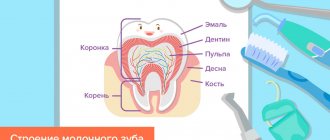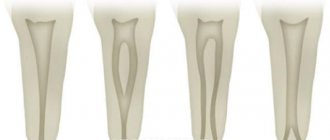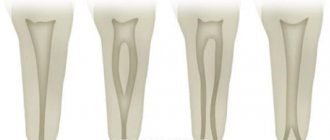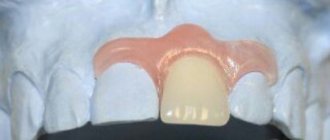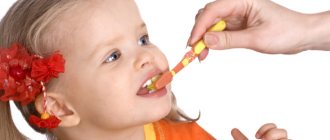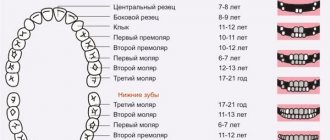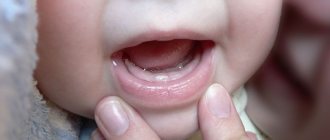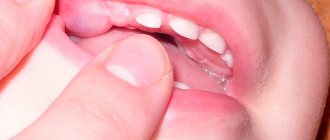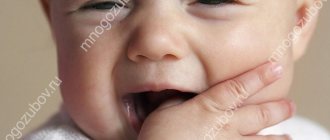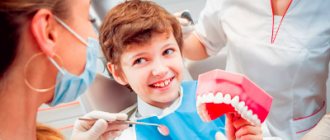Cough
Most often, children develop a wet cough during the period of the appearance of incisors, canines and molars. His attacks are rare. This usually happens in a horizontal position when the child is lying down. It goes away in 2-3 days. But, young mothers should remember that frequent manifestations of a wet cough may indicate serious illness. You need to see a doctor to rule out bronchitis and pneumonia. If symptoms are severe, you should not delay a visit to the pediatrician.
Vomit
This unpleasant state at the birth of units can be explained.
- With strong salivation, the child does not have time to swallow saliva. It drains, accumulates in the mouth and is expelled by reverse peristalsis.
- Painful condition, crying and screaming contribute to swallowing air. It gathers in large quantities, props up the diaphragm, the little ones arch and saliva, along with food, spews out.
- Refusal to eat provokes mothers to force-feed. In such a situation, food is rejected by the body.
Vomiting can be provoked by high temperature, decreased immune status, which is fraught with the introduction of pathogenic microflora. Intoxication leads to vomiting. This is how the body cleanses itself of toxins. It is important to avoid dehydration. Remember that in a child’s body it occurs quickly. Therefore, contacting a pediatrician is mandatory.
An examination of the oral cavity will reveal a violation of the closure of the jaws and their uneven growth. This may be a consequence of prolonged use of the pacifier. Correcting the bite in children is an important component of overall health. A mandatory visit to the pediatric dentist is carried out no later than 6 months of age. The doctor will evaluate the position of the upper and lower lips, the condition of the frenulum, and the features of the maxillofacial structure.
Diarrhea
Watery bowel movements, that is, diarrhea, are also noted at the birth of the masticatory organs. If stool is not frequent, no more than 2-3 times a day, and this trouble lasts from 1 to 3 days, mothers should not worry. If you have frequent bowel movements with the appearance of blood clots, you should contact your pediatrician, especially when you experience abdominal pain. You cannot self-medicate, it is dangerous for the baby’s health. In such a situation, dehydration is detrimental. Only a doctor can make the correct diagnosis and help cope with the problem.
Why are the first teeth called baby teeth?
There are several opinions on this matter. Doctors attribute the authorship of the term to Hippocrates, who believed that these teeth are formed from mother's milk. Philologist N.N. Vashkevich states that “the term is a tracing from the Latin lactose “milk”. But the tracing paper is false, it is a misunderstood Arabic liwaqt - “for a while,” “temporary.”
One way or another, the first teeth actually actively “feed” on breast milk, since it is from it that the child absorbs the main building material of teeth and bones – calcium. And although baby teeth erupt, as a rule, at 6-7 months, their formation in the child’s jaws occurs long before that.
It is worth noting that for the health and strength of the first teeth, it is mother’s milk (not cow’s) that is necessary, since the nutrients from it are maximally absorbed by the baby’s body. Therefore, the universal recipe “breastfeed your baby” will help in this matter.
When do baby teeth appear?
The rudiments of baby teeth appear in the embryo at about 5-7 weeks of pregnancy. By the time a child is born, the crowns of 10 temporary and 8 permanent teeth have already been formed in his jaws. The timing of the eruption of baby teeth is quite arbitrary. The average formula is as follows: the child’s age in months minus 6. That is, the first 2 teeth (usually the lower middle incisors) appear at 6-7 months, the next 2 (upper middle incisors) at 8-9 months. Next, the upper lateral incisors usually come out, then the lower lateral incisors, then the front molars, canines, and back molars. Thus, by the age of 2-2.5 years, the child should have all 20 milk teeth. These are ideal timing and ideal sequence; deviations from them are quite common. Teeth may begin to appear as early as 4 months, or may linger for up to 8-9 months. In rare cases, a baby is born with teeth already erupted.
If your little one doesn’t “meet the deadline,” don’t be alarmed. This does not mean that the child is developmentally delayed. You should also not be proud of the early appearance of teeth - it does not indicate the child’s superpowers. Early or late appearance of teeth may be a hereditary factor. In case of a strong deviation from the schedule - the appearance of teeth before 4 months or their absence after 9 months - just show the baby to the pediatric dentist. In general, the first examination by a pediatric dentist should be scheduled at least when the child is one year old. The doctor will see how the teething process is progressing and talk with you about the baby’s oral hygiene. The baby will get acquainted with the environment of the office, with the doctor, will get the first positive experience of visiting the dentist, because nothing unpleasant awaits him during this visit, and funny pictures on the walls of the clinic, toys, a chair in which he can ride with his mother - all this will certainly have an impact on him. him a good impression. From now on, you should take your child to the pediatric dentist at least twice a year.
Teething order
Diagram of the eruption of baby teeth (numbered in order of priority)
Finding out the sequence of teeth appearance in children will be useful for young parents who have already felt the joy of becoming a mother and father, or this is still to come in the future. By the end of the first year, children have several teeth. The number is determined by a number of factors. One reason is heredity.
Problems in the baby’s body that arise as a result of:
- low calcium content in the body and the formation of rickets.
- dysfunction of the thyroid gland and, as a result, a decrease in hormones in the blood.
- absence of incisors (edentia).
- dysfunction of the gastrointestinal tract.
Baby teeth
While still in the womb, the rudiments of dental formations are formed in the fetus. And by the middle of pregnancy, the required number and order of appearance of one or another incisor is formed.
It must be taken into account that a child’s oral bone formations should number 20. The time of eruption of baby teeth and the order are of a purely individual nature. However, there are generally accepted norms, which are an indicator of the correct physiological development of the baby. So how do children usually grow their teeth? Let's take a closer look at this topic.
First tooth
In babies, the first pair of teeth appears on the lower jaw. Which tooth of a given pair should appear first? Pediatricians say that teeth can erupt at the same time or with an interval of several days. And you shouldn’t worry about which incisor appeared first, because there are no special rules for this. Usually, young parents are happy to see their child’s first tooth appear at 6-7 months of his life. But at the same time, the scope of the norm expands significantly - from 4 to 9 months.
Second pair
Following the growth of the lower incisors, the upper ones should appear. The order in which the right or left incisor appears first does not matter. The interval between their occurrence can vary from several hours to two weeks.
According to statistics, the upper incisor appears first on the side from which the lower one appeared. The upper teeth normally erupt at 5-11 months. Usually at eight months.
Third pair
How does a child’s teeth continue to grow? After the child begins to smile with his 4 teeth, his lateral incisors, which are located on the upper jaw, appear. The third pair of bone formations appears at 10 months. Medical experts consider it normal for these teeth to erupt from 7 months to a year.
Fourth pair
The lower lateral incisors appear between 9 and 15 months.
The child's next teeth are the upper and lower molars. Normally, they appear before the fangs. But in recent years, doctors have increasingly encountered exceptions when the canines form first. And after 2-3 months, the lower molars are also replenished in the mouth.
Molars begin to grow at the age of 1-1.5 years. Let us immediately note that molars are large formations and their eruption is accompanied by high fever, lack of appetite and capriciousness of the child.
The next stage of the teething scheme is given to the canines. Fangs usually appear between the ages of one and a half to two years. But there are cases when they are formed earlier than paired molars.
Fangs, like painters, make themselves felt through the manifestation of the following symptoms: pain and itching of the gums, symptoms of rhinitis, changes in stool. These signs disappear as soon as a new tooth appears.
The second group of upper and lower molars erupt painlessly and asymptomatically at 2-3 years. This group is the final one in the chain of primary (non-permanent) teeth. After the milky bone formations of the oral cavity begin to fall out, permanent teeth will grow.
Generally accepted teething pattern
Children at 2.5 years old should have 4 incisors and 4 molars, as well as 2 canines. This scheme looks like this: 2-1-2 (2 incisors, 1 canine, 2 molars grow from above and below from each half of the jaw).
In order to determine the normality of a child’s teeth, a special formula is provided. The calculation is carried out as follows: the number of teeth should correspond to the difference in the age of the baby in months and six. For example, at 1.5 years (17 months) this number is 11 (17-6=11). The method for determining the required number of teeth is more appropriate to use for children under two years of age, then the formula will be more accurate.
First teeth: symptoms of their eruption
The progress of teething is usually accompanied by certain symptoms. These signs are reflected in behavior and emotional state. The following manifestations are considered normal:
- secretion of saliva in large quantities. This symptom usually appears at the end of 2 months and can last up to 4.
- looseness and hyperemia of the gums – lasts for quite a long time.
- skin irritation in the lips and chin area. The appearance of an allergic reaction is caused by excessive salivation. To prevent irritation on the baby's delicate skin, parents should wipe his mouth more often and lubricate the skin with baby cream. For better absorption of the cream, it is better to apply it at night.
- The gums turn red and begin to itch. This manifests itself when the baby is breastfeeding, because he bites the nipple.
- the presence of pain disrupts the baby's sleep. For some time he will not be able to fall asleep on time, and the duration of sleep will be shorter. During this period, some pediatricians recommend giving the baby analgesics.
- Lack of appetite and refusal to eat are common problems during the teething stage. This symptom is caused by pain when eating food. The exception is the mother's breast.
- thumb sucking or the desire to chew on something. Most often, the child puts into his mouth any object that catches his eye and begins to gnaw on it. Therefore, it is necessary to ensure that toys and other items are clean.
- hematomas or bruises - medium-sized bulges on the gums with a bluish tint. There is no need to worry about their occurrence if their number is insignificant. You can apply cold compresses to the bumps. The hematomas will gradually disappear on their own.
All of the above signs have virtually no effect on the baby’s behavior and well-being, and disappear after teeth appear.
How to help a child with incisor teeth?
As soon as the baby begins to be bothered by the symptoms associated with the manifestation of incisors, parents begin to look for ways to eliminate negative phenomena. There are many tips and recommendations from specialists that can help you survive this stage of a child’s development more easily and without any consequences.
How can I make teething easier for my baby?
- You should provide your child with objects that he can chew on. This will relieve his anxiety and massage his gums.
- For this purpose, rubber toys filled with liquid or gel filler are best suited. They are designed to achieve a cooling effect on the gums. The main disadvantage of such items is that they will have to be periodically placed in the refrigerator.
- Pacifiers or bottles. The chewing or sucking mechanism helps soothe irritated gums. It should be taken into account that regular sucking and chewing of objects with an irregular shape can cause the formation of an abnormal bite. That is why it is necessary to purchase a pacifier with a special shape and made of high-quality material.
- A finger brush is a remedy for eliminating itchy gums in a baby. Recently, it has become increasingly popular and in demand among young mothers, because in addition to its main action, the brush is an assistant in caring for the oral cavity of babies.
- At home, in the absence of special care items, it is possible to use gauze swabs, which are pre-moistened in cold water. This method simultaneously eliminates itching and cleanses the oral cavity of microorganisms. Massaging the gums with a gauze swab should be done carefully, gently, without sudden movements that can injure the oral mucosa.
- Most methods are ineffective. In extreme cases, resort to medication. Pharmaceutical companies offer a huge number of special gels and ointments for topical use. It is better to select the appropriate remedy together with your pediatrician.
My baby is teething - how can I help him?
The child's profuse salivation will tell you that the first tooth is on the way. 1-2 months before the first tooth erupts, the baby’s saliva begins to flow so actively that it is already difficult to do without aprons and bibs.
All your older relatives will probably tell you about the unpleasant side effects of teething. However, there are many misconceptions here.
The very first teeth usually come out painlessly. What most often happens is this: while spoon-feeding a child, the mother hears the sound of metal on the edge of a tooth - that is, she detects an event that has already happened, without even noticing anything unusual in the child’s behavior.
The emergence of canines and molars may be more difficult. The baby may be capricious, refuse to eat, sleep poorly, and put everything in his mouth. You should take care of inflamed gums - regularly treat them with special gels, offer your child to chew a cooling ring (cold relieves pain well).
However, do not believe that an increase in temperature is associated with teething. Fever and catarrhal symptoms are caused by an infection that is “caught” by the child’s body, weakened by malnutrition and lack of sleep. That is why, during the period of teething, it is better to protect the baby from communicating with strangers. Digestive disorders, an upset stomach of a child at the time of teething, is associated with his desire to chew and suck everything he can reach, just to relieve discomfort in the gums. This is how pathogenic microbes enter his mouth. Try to surround your child with clean objects, wash his hands and toys more often. Regularly let your baby chew small pieces of solid food - dried bread, bagel, apple slice, etc. This will help the teething of those teeth that are already “on the way”, improve blood supply, and therefore nutrition of the gums, develop the chewing reflex, and help the formation of the speech apparatus.
When should you start brushing your child's teeth?
Now pediatric dentists are inclined to believe that systematic cleansing of a child’s oral cavity should begin... from the first days of his life. After feeding, you need to take clean gauze or a bandage, wrap it around your finger, moisten it with boiled water and rub it over the newborn’s gums. This is how you can avoid such major troubles as, for example, oral candidiasis (thrush).
Cleaning the first teeth can be done with a cotton swab or fingertip. You should start using toothpaste and brushing at 12-14 months. Almost all children's brushes are now made from soft artificial bristles, but still be careful and check the brush you like: what age it is designed for, and whether it is soft enough. Give preference to products from well-known manufacturers. Toothpaste also differs in composition and taste depending on the age of the children for whom it is intended. The child should be explained that toothpaste should be spat out, even though it is sweet. However, keep in mind: nothing bad will happen if a child swallows a certain amount of paste at first: manufacturers are aware of this tendency of children and make children's pastes safe for the body.
Of course, it is necessary to involve the child in the dental care process as much as possible: show how to use a brush correctly, brush your teeth in the presence of the child, thereby demonstrating how important this procedure is. You can involve your baby in the process of choosing toothpaste and brush, especially since the brush needs to be changed every 3 months. A slightly older child can be asked to choose brushes for the whole family. It is necessary to develop in your child the skill of regular brushing of teeth 2 times a day. More attention should be paid to brushing your teeth at night. And yet, you can let go of the situation and leave the child to his own devices in matters of oral hygiene only when the child turns 10 years old.
Features of teething
Teething can be painless, without disturbing the baby’s well-being or changing his behavior. However, in most cases, this process is accompanied by hyperemia, fever, refusal to eat and many other symptoms.
At this stage of child development, all dads, and especially moms, need to be patient and prepare themselves for the fact that the period of teething may be accompanied by severe symptoms.
Modern parents are very worried about this problem, so they try to carefully read the necessary literature, learn from the experience of relatives, in order to prepare for the appearance of the first incisor. More often, mothers find plans that provide the required number of teeth at a given period of age, and if there are no expected results within the specified period, they begin to panic.
Is it possible to know in advance which tooth will make itself known first? In what order do children's teeth appear? It is quite difficult to answer questions with accuracy, since each organism is special and its development occurs in its own way.
Diseases of baby teeth
The most common troubles are caries (including bottle caries), pulpitis, periodontitis.
You should be alerted to any changes in the color of the enamel, spots, dots (both dark and white) on the child’s teeth, redness or swelling of the gums. But you don’t have to be afraid of uneven teeth at first: when chewing solid food, the baby teeth will move a little and gradually take the right place.
The causes of diseases in primary teeth are not very different from the causes of problems with permanent teeth. This:
- insufficient care for them (lack of proper hygiene),
- eating disorders,
- undermining of the immune system due to other diseases and taking certain medications.
It is a mistake to think that you can't take too much care of your baby teeth because they will fall out anyway. A diseased tooth in the mouth is a breeding ground for pathogenic bacteria, which not only destroy other teeth, but also negatively affect digestion and ENT organs. A prematurely lost baby tooth is also a problem, as it does not allow the baby to fully chew food or articulate sounds well. In addition, neighboring teeth try to occupy the vacated space - they move. And when a permanent tooth begins to grow here, it simply does not have enough space in the dentition and will have to grow sideways. That’s why it’s imperative to keep an eye on your baby teeth and treat them on time!
We ourselves, out of ignorance, introduce some pathogenic bacteria into the baby’s oral cavity. Suffice it to remember my grandmother’s method of disinfecting a fallen pacifier: lick it and put it in the baby’s mouth. How many times have we done this? Did you feed the child with your spoon? Did you take turns biting an apple or a bun with him? Imagine for a moment the state of your teeth and the newly formed, not fully formed, delicate teeth of the child. What danger did you expose them to?
Foreign microflora is especially harmful to a child under 2 years of age, while temporary teeth are maturing in his mouth and their enamel is very vulnerable.
Leftover food also contributes to the rapid proliferation of bacteria in the oral cavity. A by-product of their activity is acid, which eats away the enamel of a baby tooth, leaving its delicate base - dentin - without protection. Then it’s a matter of little things: microorganisms penetrate the dentin and destroy it. This is how caries occurs. Outwardly, a diseased tooth may look normal for quite some time: a small black dot (the site of the lesion) is not too noticeable. But inside it can already be severely damaged, since caries of baby teeth, due to the softness of their tissues, develops much faster than permanent teeth.
There is also the so-called “bottle caries” - this is a brownish plaque on the front teeth. It is very resistant and cannot be cleaned with a brush. Such teeth rot quickly. This caries is called “bottle caries” because it is a consequence of feeding the baby from a bottle with sweet drinks and juices at night and throughout the night. Carbohydrates are known to be the best food for bacteria. Receiving such wonderful nutrition, pathogenic bacteria rapidly multiply and take over the entire territory available to them. It will be very difficult to force them to give up their positions. The development of “bottle caries” is also facilitated by the fact that at night the natural protector and cleaner of teeth – saliva – is almost not produced. While you are sleeping peacefully, your baby’s fragile little teeth are under powerful attack and are not protected by anything! Is it worth it to buy yourself a vacation at such a price?
Dangerous complications of caries are pulpitis and periodontitis.
Pulpitis is an inflammation of the pulp (the core of the tooth, filled with vessels and nerve fibers). In children, the pulp is practically insensitive, so they may not feel the usual sign of pulpitis - sharp pain. As a result, pulpitis of baby teeth may not be noticed even by an attentive parent, and the role of preventive examinations by a dentist is irreplaceable here.
If bacteria pass through the root of a baby tooth and enter the gum tissue, inflammation begins - periodontitis. Severe pain and fever are already guaranteed here. The gums become red and swollen. Periodontitis is a serious disease, and a child should never be exposed to it.
By visiting your dentist in a timely manner, you can avoid all these troubles. Caries is very easy to treat. Here, however, the first question comes to mind: where exactly to turn. It turns out that the approach to the treatment of baby teeth in different clinics is very different.
Traditionally, caries of primary teeth is treated “in a hurry”: a small child usually does not really want to endure while the doctor picks around his mouth, so the doctor tries to somehow clean the damaged area and fill it with quick-hardening material. As a result, the affected teeth remain untreated and may soon become inflamed again or completely collapse. Sometimes you even have to put crowns on baby teeth.
“The Nutcracker” uses all the possibilities of modern medicine to provide comprehensive care to the smallest patients: from composite materials to “laughing gas” and Sevoran anesthesia. We are convinced that the treatment of primary teeth should be of high quality, and the child’s impressions of the clinic should be the most pleasant.
When to sound the alarm
Attentive attitude to the child during the development of masticatory organs will help not to miss pathologies. Private pediatric dentistry can identify diseases in the early stages and, if necessary, provide assistance. You should start visiting a pediatric dentist at 5-6 months, when the first teeth appear. A pathological process may be indicated by:
- Failures in the formation of primary and mammary units, their irregular shape, unnatural color and size;
- Eruption of incisors, canines and molars outside the dentition;
- Absence of most units after 3 years.
Consulting a doctor and diagnostic tests will reveal the problem. It is important to monitor not only the location of each unit, but also record their color. If the incisor has a black edge, there is an inflammatory process in the body. With a greenish-yellowish color, disturbances in the metabolic processes of bilirubin or the death of red blood cells are diagnosed. The brown color appears after long-term use of antibiotics. A reddish tint indicates congenital disorders in the metabolism of pigment such as porphyria.
Thin and soft enamel requires special care. Dentists recommend using a specific fingertip. It does not have a smooth surface, but with pimples. It is not advisable to use toothpaste at this age. Regular visits to the dentist and preventive measures will ensure that the units erupt without complications.
What should you do to keep your baby teeth healthy?
Let’s summarize all those simple and, in general, obvious rules that will help us preserve the baby’s healthy baby teeth given by nature throughout the entire period of their functioning and not lead to the moment when the child’s baby tooth hurts or its premature loss occurs.
- Avoid unnecessary use of medications during pregnancy and breastfeeding to avoid damaging developing teeth.
- Eat right during pregnancy.
- Feed your baby breast milk.
- Introduce solid foods into your child's diet in a timely manner.
- Do not share food with your child (especially before the age of two), and do not lick his pacifier for the purpose of “disinfection.”
- Don't let your child fall asleep with a bottle of sugary drink.
- Carefully monitor your child’s oral hygiene from the first days of life.
- Have your child undergo regular preventive examinations with a pediatric dentist.
Typical problems.
PHOTO: a child’s teeth at 3 years old. Gaps between baby front teeth at age 3 are normal. On the front upper teeth there is caries in the cervical area of the teeth.
There may be a slight rise in body temperature and anxiety in children when their first teeth are cut. This is due to minor inflammation and itching of the gums in the area where teeth are about to erupt. To relieve discomfort, it is recommended to treat the oral cavity with special napkins for oral hygiene, containing special antiseptic and tanning substances.
The most common problem faced by parents aged 12 - 18 months is “bottle” caries, the main cause of which is poor oral hygiene in the child and night feedings. As a result of poor hygiene, a large amount of soft plaque forms on the teeth. Plaque contains a large number of bacteria that produce acid, which “corrodes” the enamel, leading to the formation of caries.
Night feedings at the age of 12 - 18 months create the most favorable conditions for the development of caries, because... At night, saliva production is reduced - the acid of bacteria living in dental plaque is not neutralized.
BREAST-fed children are LESS likely to develop dental caries than bottle-fed children. Breast milk helps saturate the surface of teeth with calcium and phosphate ions. Breast milk contains a large number of immunological protective factors. At the same time, it has been noted that long-term night feeding (both breast and bottle feeding) leads to the development of dental caries, especially in the area of the upper front milk teeth.
PHOTO: A one and a half year old child’s teeth. The front incisors and first molars have erupted. The fang (3rd tooth) is emerging. Often at this age the first injuries occur: the child fell and hit his front upper tooth - the tooth broke.
Against the background of poor hygiene and a weakened immune system, inflammatory diseases of the mucous membrane and stomatitis may develop. Stomatitis in young children is severe, accompanied by general malaise, loss of appetite and increased body temperature.
IT IS VERY IMPORTANT TO START TEACHING YOUR CHILD TO THE NECESSITY OF INDIVIDUAL ORAL HYGIENE FROM THE MOMENT OF THE APPEARANCE OF THE FIRST TEETH. GOOD ORAL HYGIENE IN A CHILD IS THE KEY TO HEALTHY TEETH FROM EARLY CHILDHOOD.
